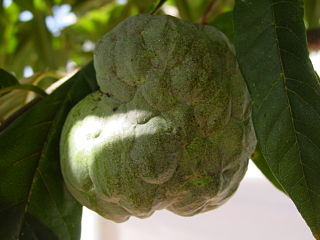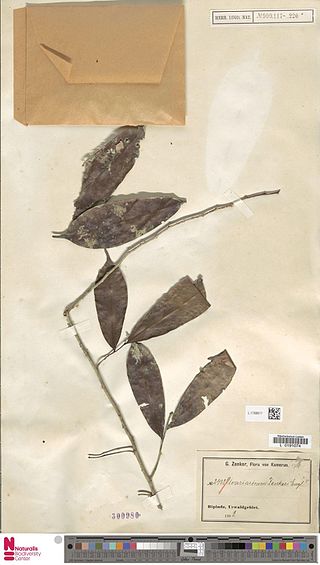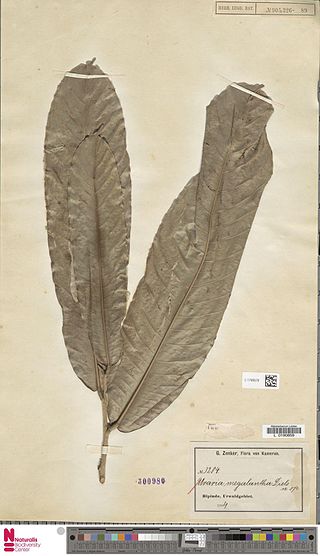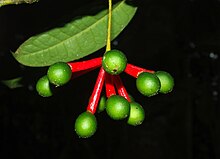
Royal Botanic Gardens, Kew is a non-departmental public body in the United Kingdom sponsored by the Department for Environment, Food and Rural Affairs. An internationally important botanical research and education institution, it employs 1,100 staff. Its board of trustees is chaired by Dame Amelia Fawcett.

The Annonaceae are a family of flowering plants consisting of trees, shrubs, or rarely lianas commonly known as the custard apple family or soursop family. With 108 accepted genera and about 2400 known species, it is the largest family in the Magnoliales. Several genera produce edible fruit, most notably Annona, Anonidium, Asimina, Rollinia, and Uvaria. Its type genus is Annona. The family is concentrated in the tropics, with few species found in temperate regions. About 900 species are Neotropical, 450 are Afrotropical, and the remaining are Indomalayan.

Anonidium is a genus of plants in family Annonaceae.
Pseudoxandra laevigata is a species of plants in the custard apple family Annonaceae. It is endemic to Peru.
Oxandra is a genus of flowering plants in the custard apple family Annonaceae, native to Mexico and tropical America.
Tetrameranthus is a genus of plant in family Annonaceae. It contains 8 species, all occurring in South America.

Unonopsis is a genus of plants in the family Annonaceae native to southern Mexico and tropical America.

Uvariastrum is a genus of plants in the Annonaceae endemic to sub-Saharan Africa. One species of the genus grows in a drier woodland habitat, whereas the other species are found in the tropical lowland rain forests.

Uvariodendron is a genus of plants in the family Annonaceae. It contains the following species :
Ulmus × hollandica var. insularum was recognized as a biometrically distinct population of U. × hollandica endemic to all the Channel Islands and the Cotentin Peninsula of France by Richens and Jeffers in 1975. As of January 2025, Plants of the World Online did not accept this or any other varieties of U. × hollandica, treating them all as synonyms of the hybrid species.

Cremastosperma is a genus of flowering plants in the family Annonaceae, subfamily Malmeoideae, tribe Malmeae. In 2018 there were 34 recognised species distributed in Central and South America.

Cremastosperma cauliflorum is a species of plant in the family Annonaceae. It is native to Brazil, Colombia, Ecuador and Peru. Robert Elias Fries, the Swedish botanist who first formally described the species, named it after its flowers which grow from its main trunk or stem.

The Malmeoideae are a subfamily of trees and other plants of the family Annonaceae.

Afroguatteria is a small genus of flowering plants in the family Annonaceae, native to Cabinda and Zaire in west Africa. They are climbers, and are closely related to Toussaintia.

Cardiopetalum is a genus of flowering plants belonging to the family Annonaceae and native to southern tropical America.

Desmopsis is a genus of flowering plants belonging to the family Annonaceae.
Maasia is a genus of flowering plants belonging to the family Annonaceae.
Ephedranthus is a genus of flowering plants belonging to the family Annonaceae.
Letestudoxa is a genus of flowering plants belonging to the family Annonaceae.
Pseudomalmea is a genus of flowering plants belonging to the family Annonaceae.












